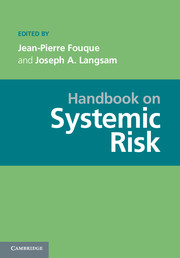Book contents
- Frontmatter
- Contents
- Contributors
- Introduction
- PART I DATA: THE PREREQUISITE FOR MANAGING SYSTEMIC RISK
- PART II STATISTICS AND SYSTEMIC RISK
- PART III MEASURING AND REGULATING SYSTEMIC RISK
- 8 Measuring Systemic Risk
- 9 Taxing Systemic Risk
- 10 Analyzing Systemic Risk of the European Banking Sector
- PART IV NETWORKS
- PART V SYSTEMIC RISK ANDMATHEMATICAL FINANCE
- PART VI COUNTERPARTY RISK AND SYSTEMIC RISK
- PART VII ALGORITHMIC TRADING
- PART VIII BEHAVIORAL FINANCE: THE PSYCHOLOGICAL DIMENSION OF SYSTEMIC RISK
- PART IX REGULATION
- PART X COMPUTATIONAL ISSUES AND REQUIREMENTS
- PART XI ACCOUNTING ISSUES
- References
9 - Taxing Systemic Risk
from PART III - MEASURING AND REGULATING SYSTEMIC RISK
Published online by Cambridge University Press: 05 June 2013
- Frontmatter
- Contents
- Contributors
- Introduction
- PART I DATA: THE PREREQUISITE FOR MANAGING SYSTEMIC RISK
- PART II STATISTICS AND SYSTEMIC RISK
- PART III MEASURING AND REGULATING SYSTEMIC RISK
- 8 Measuring Systemic Risk
- 9 Taxing Systemic Risk
- 10 Analyzing Systemic Risk of the European Banking Sector
- PART IV NETWORKS
- PART V SYSTEMIC RISK ANDMATHEMATICAL FINANCE
- PART VI COUNTERPARTY RISK AND SYSTEMIC RISK
- PART VII ALGORITHMIC TRADING
- PART VIII BEHAVIORAL FINANCE: THE PSYCHOLOGICAL DIMENSION OF SYSTEMIC RISK
- PART IX REGULATION
- PART X COMPUTATIONAL ISSUES AND REQUIREMENTS
- PART XI ACCOUNTING ISSUES
- References
Summary
Systemic risk and the financial crisis of 2007 to 2009
In the fall and winter of 2008 to 2009, the worldwide economy and financial markets fell off a cliff. The stock market fell 42 percent in the United States and, on a dollar-adjusted basis, the market dropped 46 percent in the United Kingdom, 49 percent in Europe at large, 35 percent in Japan, and around 50 percent in the larger Latin American countries. Likewise, global gross domestic product (GDP) fell by 0.8 percent (the first contraction in decades), with the decline in advanced economies a sharp 3.2 percent. Furthermore, international trade fell a whopping 12 percent.
When economists bandy about the term systemic risk, this is what they mean. Financial firms play a critical role in the economy, acting as inter-mediaries between parties that need to borrow and parties willing to lend or invest. Without such intermediation, it is difficult for companies to get credit and conduct business, and for people to get student loans and automobile loans, to save, and to perform a range of other financial transactions. Systemic risk emerges when the financial sector as a whole has too little capital to cover its liabilities. This leads to the widespread failure of financial institutions and/or the freezing of capital markets, which greatly impairs financial intermediation, both in terms of the payments system and in terms of lending to corporations and households.
- Type
- Chapter
- Information
- Handbook on Systemic Risk , pp. 226 - 246Publisher: Cambridge University PressPrint publication year: 2013
References
- 15
- Cited by



